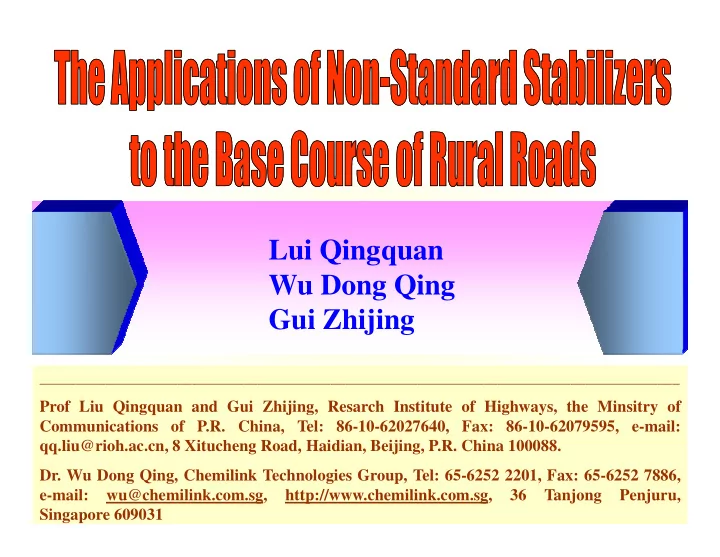

Lui Qingquan Wu Dong Qing Wu Dong Qing Gui Zhijing ________________________________________________________________________________________ Prof Liu Qingquan and Gui Zhijing, Resarch Institute of Highways, the Minsitry of Communications of P.R. China, Tel: 86-10-62027640, Fax: 86-10-62079595, e-mail: qq.liu@rioh.ac.cn, 8 Xitucheng Road, Haidian, Beijing, P.R. China 100088. Dr. Wu Dong Qing, Chemilink Technologies Group, Tel: 65-6252 2201, Fax: 65-6252 7886, e-mail: wu@chemilink.com.sg, http://www.chemilink.com.sg, 36 Tanjong Penjuru, Singapore 609031
List of Contents 1. Introduction 2. Brief Review of Soil Stabilizing Materials 3. Basic Stabilizing Mechanism of Non- Standard Stabilizers 4. 4. Laboratory Test Results Laboratory Test Results 5. Field Trial Roads with Various Stabilizers 6. Conclusions 7. References
1. Introduction • High intensive investments to the national truck roads in past years in China • For examples, in Year 2003, new roads – 46,000 km including 4,600kg expressway; 46,000 km including 4,600kg expressway; new/rehabilitated/re-constructed rural roads – 102,000km . • More attentions to the rural roads in the Western China at low-cost by using local materials, such as the in-situ soils
1. Introduction • Soil stabilization with “Standard” and/or “Non-Standard” chemical stabilizers • Studies and applications of the non- standard chemical stabilizers have been concentrated for past ten years in china • The national transportation research project on – “Construction Technologies of Low-Cost Rural Roads in Western China” • In the project, comprehensive laboratory tests and 4 full trials roads (3-5km long each) have been conducted over the years
2. Brief Review of Soil Stabilizing Materials 2-1. Standard Stabilizing Agents, such as: • Cement • Lime
2. Brief Review of Soil Stabilizing Materials 2-2. Non-Standard Stabilizing Agents, such as: • Chemical Modified Cement - / Lime-Base Stabilizers in Powder Form • Enzyme-Base Stabilizers in Liquid Form • Various compound chemical stabilizers
3. Basic Stabilizing Mehanism of Non-Standard Stabilizers 3-1. Non-Standard Stabilizers in Powder Form • Chemical Reactions • Physical-Chemical Reactions • Physical Reactions 3-2. Non-Standard Stabilizers in Liquid Form • Changing of Surface Energy • Exchange of Irons • Setting up Net-Shape Structure • Forming of Water-Repellent Materials
4. Laboratory Test Results
4. Laboratory Test Results
4. Laboratory Test Results
4. Laboratory Test Results
4. Laboratory Test Results Important Conclusions derived from both strength test results : i) The non-standard modified cement-base i) The non-standard modified cement-base stabilizers in powder form have outstanding performances in strengths among the whole stabilizer family which includes the standard ones and non- standard ones;
4. Laboratory Test Results Important Conclusions derived from both strength test results : ii) The strengths of the non-standard ii) The strengths of the non-standard stabilizers in powder form with three types of soils are much higher than those of cement-soils or lime-soils and generally better than those of the combined stabilizers; and
4. Laboratory Test Results Important Conclusions derived from both strength test results : iii) To add the stabilizers in liquid form into cement-soils or lime-soils cannot significantly improve their compressive significantly improve their compressive strengths and even make them worse (except the case of PM stabilizer with cement-silt with surprising), while the adding of the stabilizers in liquid form looks partially useful for increasing of the elasticity of the mixtures;
4. Laboratory Test Results • The drying – shrinkage due to loss of water is primary • The shrinkage caused by temperature is only 1%-2% of that caused by loss of water
5. Field Trial Roads with Various Stabilizers 5-1. Stabilization Methods * In-Situ mixing Preparation Spreading of the powder Mixing Mixing of the powder of the powder Spreading & Mixing of Compaction the Liquid Stabilized Base after Curing Curing * Central Plant Mixing
5. Field Trial Roads with Various Stabilizers 5-3. Field Test Results ����������� ������������������� • 4 Trial roads with 3-5 km long in Sichuan (South-West China), Nei Monggol (North-West China) and Xinjiang (Western China). (Western China). • A lot of field tests/measurements have been conducted. • The measured deflection values from the trial road – Nei Monggol are taken as example. ������������������������������������������
5. Field Trial Roads with Various Stabilizers Design Deflections • 21.8 (1%mm) – A real expressway in Northeast China with 15 years working life and 720mm thick pavement • 39.04 (1%mm) – An assumed high-grade road with 50% traffic volume of the real expressway and the same other conditions
1) A national research project on construction technologies of low-cost rural roads for Western China has been carried out and the non-standard soil stabilizers have been studied, as a part of this project, from the development history, basic stabilizing mechanisms, comprehensive laboratory tests to the large-scale field road trials with a lot of rich tests to the large-scale field road trials with a lot of rich results.
2) The laboratory and field tests results have proven that the non- standard stabilizers in powder form are generally more effective than the standard stabilizers for soil stabilizations. The non-standard stabilizers in liquid form are generally ineffective in improving the strengths of the stabilized sols but they may have some effects on improving some properties of cement-soil have some effects on improving some properties of cement-soil and lime-soil.
3) The soil stabilization with the non-standard stabilizers in powder form is a technically reliable and practically applicable construction method for rural roads and it could be cost- effective for those areas where there are lacking in good quarry materials. 4) In order to achieve better and cost-effective results, it is very 4) In order to achieve better and cost-effective results, it is very important to select the proper soil stabilizer based on various stabilization mechanisms, different types of soils and localized conditions. -THE END-
Recommend
More recommend